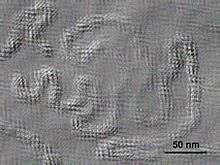Ophioviridae
| Ophioviridae | |
|---|---|
 | |
| Electron microscopy of the Citrus psorosis virus. | |
| Virus classification | |
| Group: | Group V ((-)ssRNA) |
| Order: | Unassigned |
| Family: | Ophioviridae |
| Genera | |
Ophioviridae is a family of viruses characterized by an elongated and highly filamentous and flexible nucleocapsid with helical symmetry.
The protein capsid is non-enveloped and has a constant diameter of 1500–2500 nm and a width of 3 nm, or 9 nm. The capsids form kinked circles, which can collapse to form linear duplex structures, much like a spring.
The entire genome is 1100–1200 nucleotides long.[1]
Taxonomy
The family has one genus, Ophiovirus, which has six recognized species. Members of both the family and the genus are referred to as ophioviruses.
- Order Unassigned
- Family Ophioviridae
- Genus Ophiovirus
- Species:
- Citrus psorosis virus (type species)
- Freesia sneak virus
- Lettuce ring necrosis virus
- Mirafiori lettuce big-vein virus
- Ranunculus white mottle virus
- Tulip mild mottle mosaic virus
- Species:
- Genus Ophiovirus
- Family Ophioviridae
References
- ↑ ICTVdB Management (2006). 00.094.0.01. Ophiovirus. In: ICTVdB—The Universal Virus Database, version 4. Büchen-Osmond, C. (Ed), Columbia University, New York, USA.
External links
This article is issued from Wikipedia - version of the 10/25/2016. The text is available under the Creative Commons Attribution/Share Alike but additional terms may apply for the media files.